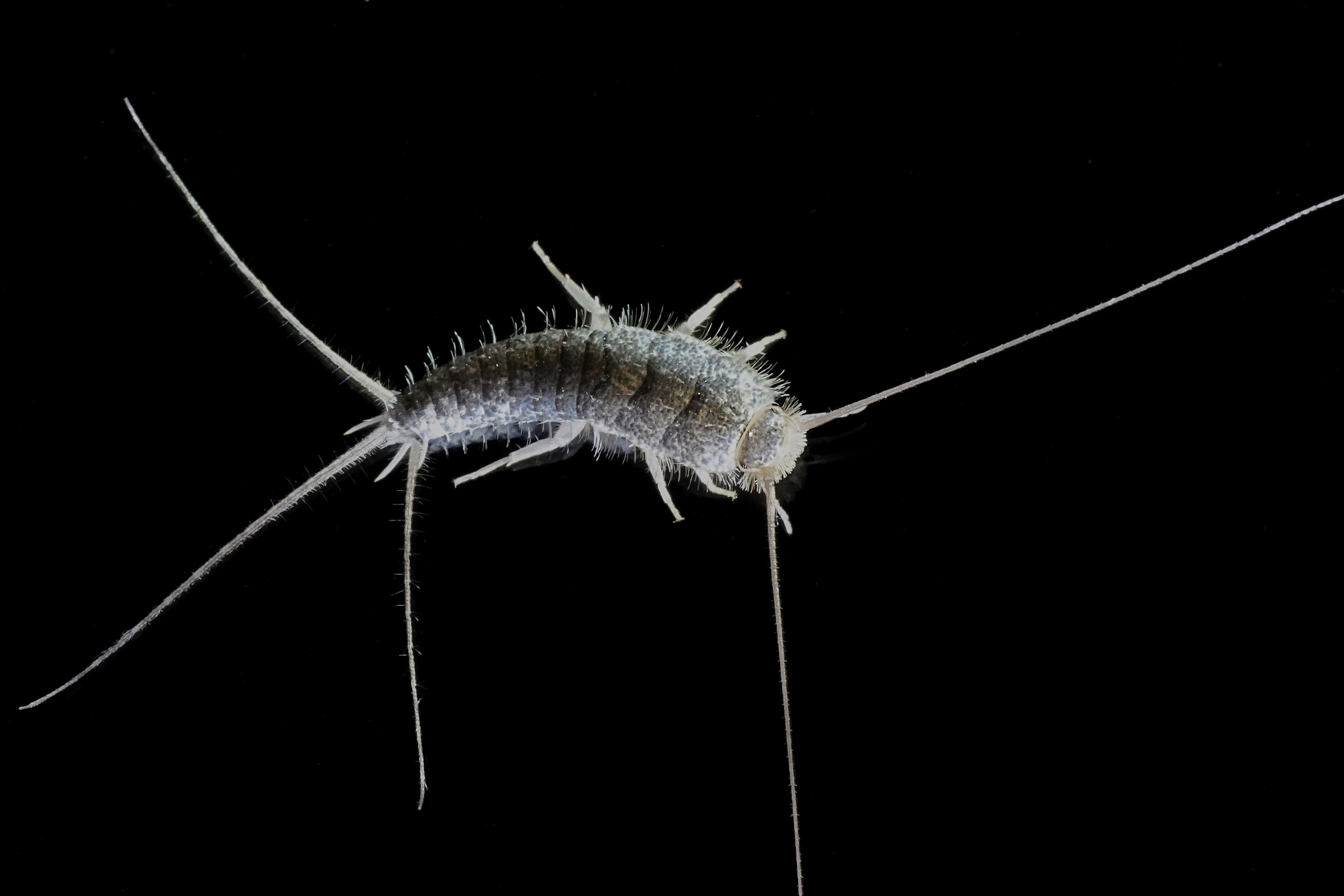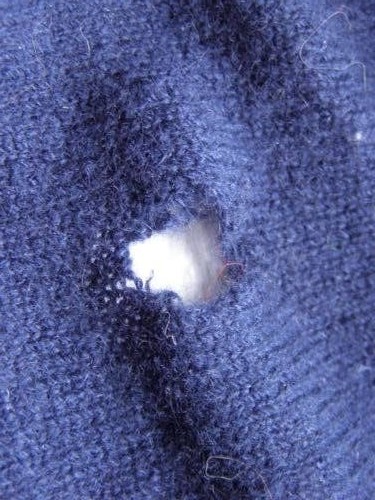
Christmastime has arrived, bringing with it all the joy and festiveness of the season. It’s the time of year when you get to excitedly unpack all the winter clothes, Christmas sweaters, and decorations you haven’t seen for a year. But as you go through all the red, green, and white you might see a bit of silver skitter across, and no, it’s not tinsel. Worse than even the shock of a mysterious bug running through your Christmas goodies is what it may have left behind. As you pull out your favorite sweater, you might notice something has chewed a hole right through it and left behind some small, black pellets (about the size of ground black pepper). Nervously going through the rest of your Christmas boxes, you may discover additional damage to your favorite clothing and decorations. So what could have caused all this destruction? Silverfish.
Though the first thoughts of things silver at this time of year are probably bells, tinsel, and a whole host of decorations (from reindeer to sleighs to trees), silverfish can play a prominent part in your celebrations if you’re not careful. These destructive critters can not only give you the creeps as they skitter around, they can severely damage some of your most beloved stored items. Fortunately, The Bug Dude is here, and though he’s not Santa, he can quickly get you back to singing “Silver Bells” instead of lamenting silverfish.

What do Silverfish Look Like?
Silverfish are an ancient, primitive insect, predating cockroaches and possibly even dinosaurs! They are around 3/4 inch long and are generally silver or gray in color with a flat body that is shaped like a carrot (wider at the head and tapering to a narrow, pointed bottom). They have 6 legs, 2 long antennae, and 3 long, bristled tail projections. Their bodies are covered in tiny shimmery scales, which are often shed and can be one of the first signs of a silverfish infestation. These scales, along with the general body shape and the side to side movement of the insect as it runs, give a sort of fish-like appearance, which led to its common name of “silverfish.”
Unlike a lot of other common household pests, silverfish have an ametabolous life cycle. This means that when they first hatch from their eggs they resemble miniature versions of the adult; they then molt several times throughout their lives (somewhere between 22 and 66 times), including as an adult.

Where do Silverfish Live?
These pests can be found throughout the world, though one of the most common continents for these critters to dwell is North America. Generally, they are found indoors in secluded, warm, humid environments, such as attics, basements, and bathrooms. However, in some cases they can be found in garages, sheds, and in some landscaping around a house. They are nocturnal, excellent climbers, and can move extremely quickly, which means that their presence in your home is often difficult to detect unless you happen to disturb them while they are foraging or eating.
What do Silverfish Eat?
Equipped with chewing mouthparts, the diet of a silverfish consists primarily of starches, carbohydrates, and protein. Some of their preferred food items are: paper (especially glazed paper), books, cardboard, glue, wallpaper, clothing, carpets, curtains, fabrics (linens, silk, cotton, plush furniture coverings), cereals, rolled oats, flour, sugars, cellulose, vegetables, dried meat, dead insects (including other silverfish), and even human hair that’s been shed. This makes stored paper and cloth goods in an attic an especially tempting target for a holiday buffet for these insects. Even worse, they are extremely resistant to starvation, and can survive for up to a year without food and weeks without water.

Are Silverfish Dangerous?
Fortunately, silverfish are not directly dangerous to humans or pets: they don’t bite or sting and are not toxic. However, their molted skins and scales can instigate or worsen an allergic reaction to common household allergens, such as dust and dust mites. In addition, these molted skins and scales can propagate a carpet beetle issue by increasing their food sources.
The greatest danger from these insects, by far, is to your treasured possessions. From family photos to beloved clothing items, these long-lived (around 4 years) pests can do a lot of damage before you even know you have a problem.

How do you Prevent Silverfish?
Given their ability to go without detection for extended periods of time while they consume and multiply, it’s especially important to take preventative measures when it comes to silverfish, lest you discover them at the same time you find your treasured family photos ruined. Here are some of the best methods to reduce the likelihood of a silverfish infestation in your home:
- Maintain a regular pest control service with Mid-Cities Pest Control @ 800-310-BUGS ( 2847 ) to eliminate the pests before they have a chance to take over
- Get a dehumidifier for especially humid areas of your home
- Repair any pipe or drain leaks and eliminate any standing water
- Fix or replace any moldy or wet wood
- Seal exterior gaps in your foundation
- Replace mulch in landscaping touching your home with gravel to reduce moisture retention
- Keep stored foods (including pet food) in airtight containers
- Regularly vacuum your flooring and upholstery to remove food crumbs
- Regularly tidy your home, especially paper-goods
- Ensure that crawl spaces are properly ventilated or lined to prevent excessive moisture
- Ensure that attics are properly ventilated
- Maintain clean and clear gutters that properly drain away from your home
- Seal cracks around windows, doors, plumbing pipes, and baseboards
- Keep yard debris (leaves, cut grass, etc.) and lumber piles away from the house
- Japanese cedar essential oil can be used around areas of stored papers and clothing to help act as a repellent
How do you Eliminate Silverfish?
Though it might be tempting to try to self-treat for silverfish, these pests are notorious for being difficult to fully eradicate without the proper knowledge and products. Plus, with their ability to get into just about any crack or crevice and the speed with which they can evade detection, by the time you discover an issue, chances are you’re already facing an infestation. That’s why as soon as you see a silverfish or signs of one (molted scales or skins), you should call The Bug Dude at 817-354-5350 and have one of our trained technicians out to assess the issue and treat accordingly. Most often, just one treatment by our skilled technicians is all it takes to get you back to joyously singing Christmas carols and putting all thoughts of non-holiday silver out of your mind.
Further Reading:
“Silverfish” – Field Guide to Common Texas Insects – Texas A&M AgriLife Extension
“Silverfish and Firebrat” – Plant & Plant Diagnostics – Michigan State University
“common name: silverfish” – Eleanor F. Phillips and Jennifer L. Gillett-Kaufman, Entomology and Nematology Department, University of Florida
“What Are Silverfish and Can They Hurt You?” – Medically reviewed by Debra Sullivan, Ph.D., MSN, R.N., CNE, COI — Written by Rachel Nall, MSN, CRNA
“Silverfish” – National Pest Management Association – PestWorld.org
“Silverfish Vs. Firebrats” – Jeffrey Tucker – PCT (Pest Control Technology)
Author Bio: Alissa Breach has been gaining knowledge and experience around pest control concerns over the last 12 years while working for Mid-Cities Pest Control. She has a creative writing BA from UW-Madison and is always pursuing new and interesting writing projects.




